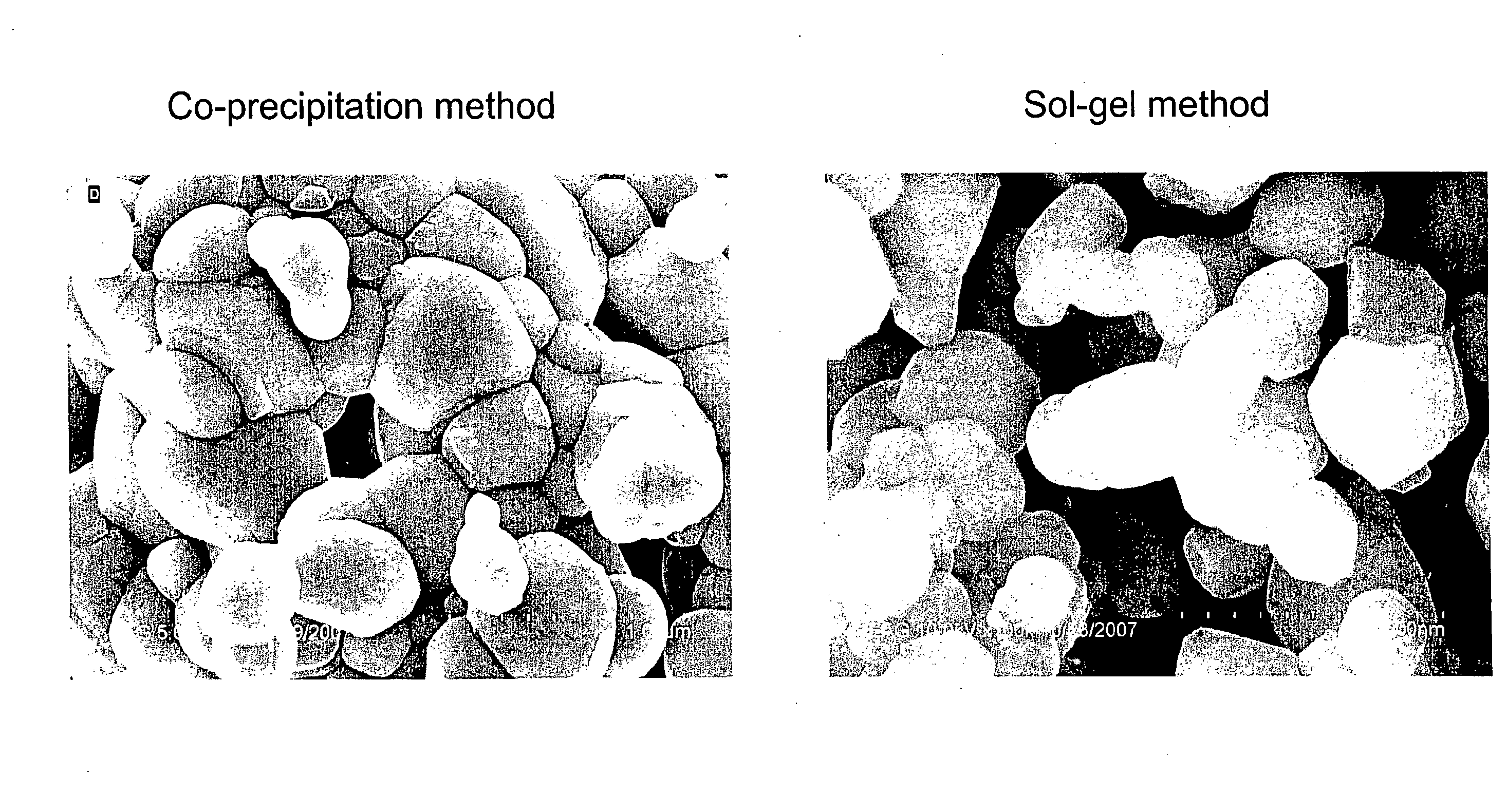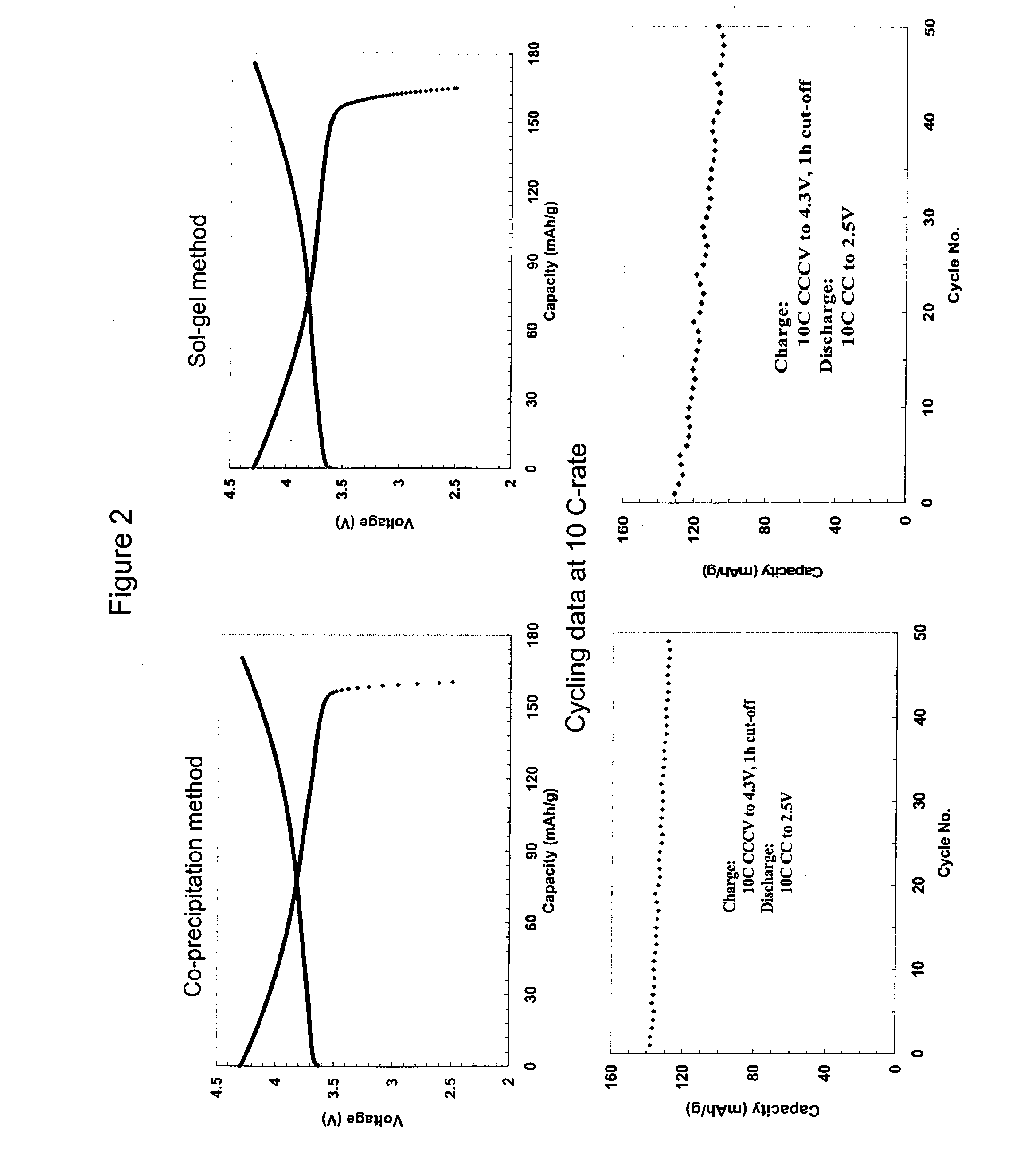Lithium batteries with nano-composite positive electrode material
a technology of nano-composite and positive electrodes, which is applied in the direction of cell components, electrochemical generators, and nickel compounds, etc., can solve the problems of low discharge rate and poor discharge system of lithium ion batteries
- Summary
- Abstract
- Description
- Claims
- Application Information
AI Technical Summary
Benefits of technology
Problems solved by technology
Method used
Image
Examples
example 1
Synthesis of Nanocrystalline Positive Electrode Material
[0032]Commercially available positive electrode material typically has a particle size of 1 micron and above. The following examples describe synthesis of positive electrode material having a nano-composite structure. The positive electrode material has the general formula: 0.1Li2MnO3-0.9LiMn0.26Ni0.37Co0.37O2. The conditions of the synthesis process can be adjusted so as to control the particle size. The particle size obtained is below 1 micron, preferably between 20 nm and 500 nm.
Synthesis by Co-Precipitation
[0033]Stoichiometric amounts of manganese acetate, nickel acetate and cobalt acetate are dissolved in deionized water. The concentration of the solution ranges from 0.01 M to 0.5 M. Then 0.1 M LiOH solution is added drop-wise to form the co-precipitated hydroxides of manganese, nickel and cobalt. The resultant slurry is filtered, washed several times and dried in an oven at 100° C. for 6 to 10 hours. The resulting materia...
example 2
Nano Coating on Positive Electrode Particles
[0036]A process is provided to coat the composite cathode particles with an inert oxide having a thickness of a few nanometers. The synthesized composite cathode particles are dispersed in an aqueous aluminum nitrate solution having a concentration of 0.2 M to 1M. Ammonium hydroxide is added drop-wise to the solution resulting in precipitation of hydrated aluminum oxide on the surface of the composite cathode particles. The resulting material is filtered and then calcined in a furnace at 400 to 600° C. for 4 to 8 hours. This results in a nano layer of Al2O3 on the surface of the composite cathode particles. A nano layer of inert oxides such as TiO2 and ZrO2 may also be coated on the surface.
example 3
Evaluation of Electrochemical Properties
[0037]Coin cells are fabricated to evaluate the electrochemical performance. Nano-crystalline composite oxide having a composition of 0.1Li2MnO3-0.9LiMn0.28Ni0.37Co0.37O2 is used as a positive electrode material. Graphite is used as the negative electrode material. The electrolyte is a mixture of ethylene carbonate and ethyl methyl carbonate containing 1M of lithium hexa-fluorophosphate (LiPF6).
[0038]The positive electrode is fabricated by first preparing a slurry of nano-crystalline composite oxide, PVDF binder, conductive carbon and n-methyl pyrrolidinone (NMP). The slurry is coated on an aluminum foil, vacuum dried and then punched to form the positive electrode. Similarly, the negative electrode is prepared from a slurry of graphite, PVDF binder, conductive carbon and NMP. The slurry is coated on copper foil, vacuum dried and punched to form the negative electrode. A polypropylene separator is placed between the positive and negative elect...
PUM
 Login to View More
Login to View More Abstract
Description
Claims
Application Information
 Login to View More
Login to View More - R&D
- Intellectual Property
- Life Sciences
- Materials
- Tech Scout
- Unparalleled Data Quality
- Higher Quality Content
- 60% Fewer Hallucinations
Browse by: Latest US Patents, China's latest patents, Technical Efficacy Thesaurus, Application Domain, Technology Topic, Popular Technical Reports.
© 2025 PatSnap. All rights reserved.Legal|Privacy policy|Modern Slavery Act Transparency Statement|Sitemap|About US| Contact US: help@patsnap.com



